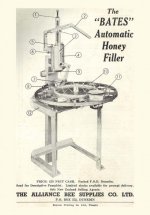Manuka honey has always been a significant 'challenge' to the beekeeping industry.
Part of it is just the thixotropic nature, making it difficult to extract and strain. By the mid-1940s, beekeepers were using "pricker pads" of various sorts. They were about 1/3 size of a frame's size, and care had to be taken to not puncture the comb's midrib. By the late 1950s there had been some attempts at 'motorising' it, but it was still pretty unwieldy and still damaged the combs.
The NZ Journal of Agriculture described several variations:
https://paperspast.natlib.govt.nz/periodicals and search for "honey pricker" (no quotes).
The strong flavour made it hard to sell to the overseas markets. I thought I remembered that even the year I was in Taranaki (1974/75) if 'manuka' could be detected, the honey received a 5 cent per kg penalty. But when I went to confirm that, it was not true: there was a deduction for strong kamahi and any thyme. (I'll have to search that a bit more!)
But all the way back to the 1920s and 30s manuka honey had been a problem to the industry. I recall one report of a Waikato beekeeper throwing the combs packed with manuka out of a truckload of honey boxes into the Waikato River to get rid of them. Extracting it just didn't make good sense, and you can only keep so much for feed. And he didn't need a resource consent.
Manuka was promoted for many years as good, up-coming source for comb honey. The marketing body felt that the more of the manuka honey that *didn't* get extracted the better - and went so far as to exclude comb honey from the provisions of the Honey Marketing Authority. The HMA was hoping it would discourage them from producing extracted manuka which the HMA found so difficult to sell.
Manuka comb honey was promoted as an ideal export to Scotland, similar as it was described to ling heather. But the market never developed like that.
Other beekeepers took a different approach for extraction rather than pricking the combs. Peter Pegram (Wairoa) described his manuka extraction very well in 1974 at the MAF Seminar. He used a modified Rosedale Plane uncapper, and cut the comb back to the midrib! There was little honey left in the frame to spin in the extractor, but the bulk of the honey came with spinning the cappings. Peter had it down to a fine art, taking a difficult honey area (as a returned serviceman) and making a good business from it.
http://www.beekeeping.nz/NZBDA/timeline/1974_MAF_Seminar.pdf#page=58 (this downloads the whole MAF Seminar document - 11Mb)
It wasn't until the 1980s that some of the newer equipment from Europe started being available. Dudley Ward (Dannevirke) promoted and imported a Norwegian honey pricker that he motorised, I believe. There was a French made machine (Thomas?), but I think it was manually operated.
I like manuka honey. Always have, ever since Taranaki in the mid 1970s when I first tasted it. I'll even admit to liking it granulated in the comb, often with crystals that are almost big enough to cut your tongue - that's not generally supposed to be a *good* thing, but I'm happy to enjoy it...
But cost and/or value? I think there has been a confusion over time between honeys for eating and enjoyment and honey for medicinal effect (most always topical/external use?). But that's another story.


